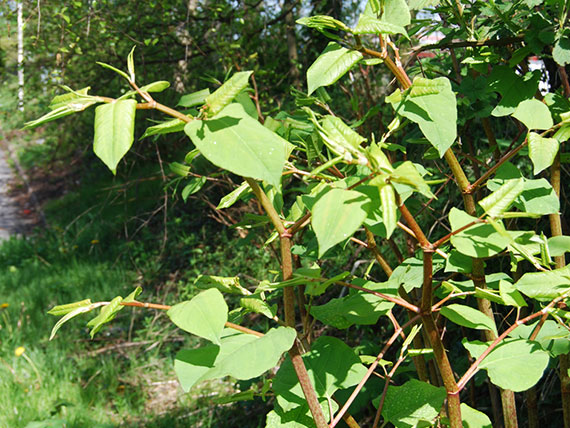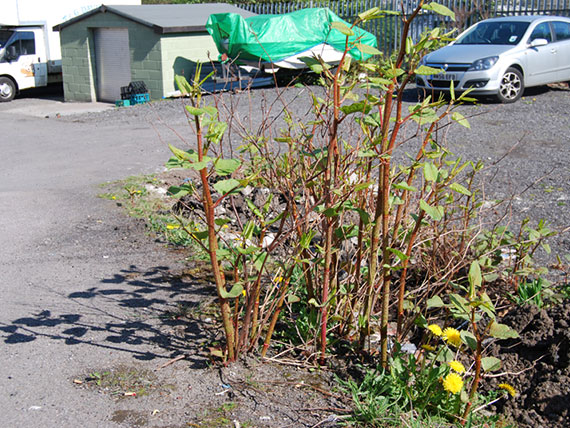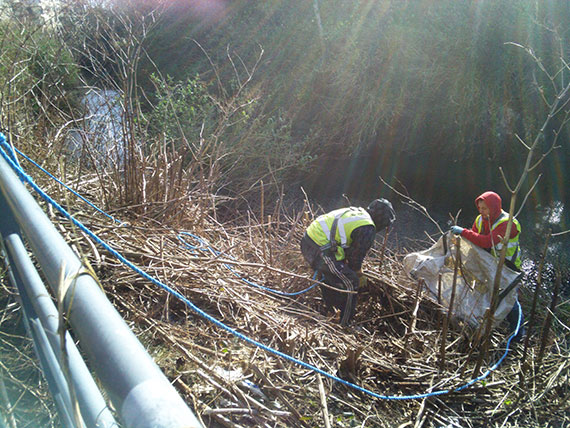We can identify and treat Japanese knotweed infestation .
We can also give advice on treating large areas appropriately where there is a short time span before excavation and development.
We also provide site specific Japanese knotweed management plans (JKMP) for development sites. Every site will have specific development plans and we can provide advise on managing the Japanese knotweed infestation accordingly.
We have professional indemnity for advising for up to 1 million euro for each and every project. This is unique in providing the client and developer with reassurance that the advise been given is professional. It also helps the developer with bio security measures to prevent contractors inadvertently spreading this specific invasive weed infestation. All JKMP are designed with before planning stage where possible.
Japanese knotweed is an invasive perennial plant species in Ireland.
- Japanese Knotweed can grow to 3-4m in just 10 weeks.
- Underground, its roots – or rhizomes – can spread 7m horizontally and compromise the structure of buildings.
- At the 10 acre Olympic site in East London, the Royal Horticultural society reported the cost of removing and disposing of Japanese knotweed was estimated at £70 million.
As a Qualified horticulturist, John understands the biology of this invasive weed. This is important, as treating incorrectly will result in poor control.
John has also recently completed courses on treating Japanese Knotweed and other invasive weeds, in the UK through the Property Care Association and is also a Certified Site surveyor and PPU (professional pesticide user).
He also carries €1M Professional Indemnity for advising on site specific treatment methods for developments.
Control Measures
If the area of Japanese knotweed is very small, it is possible to spray the leaves and canes with herbicide to control it. In more serious infestations each cane may require injection with various translocated herbicides at specific times of the year. Severe infestations may take a number of years to eradicate.
On-site disposal
Burial must be to a depth of at least 5m. This can involve large scale engineering operations and large holes within a site.
Legal status - Republic of Ireland
At present, there are is specific legislative provisions. Section 49 of the European 2011 European Community Regulations act, prohibits the movement of vector material with specific reference to soil or spoil taken from areas infested with Japanese knotweed. Section 49 provides that any person who plants, disperses allows or causes to disperse, spreads or otherwise causes to grow in any place shall be guilty of an offence.
Section 49 also provides for a defense (if it can be proven) that the accused took “all reasonable steps and exercised all due diligence to avoid committing the offence”
“Section 67 provides that a person found guilty ‘on summary conviction, to a Class A fine (currently €5000) or imprisonment for a term not exceeding six months or both”.
For more serious transgressions, i.e. on conviction or indictment, the fine may be €500,000, or imprisonment for a term of three years, or both.
Vacant sites
If you come across it on a development site then it needs to be treated appropriately.
Japanese Knotweed has the potential to become a problem on a site especially for drainage works and hard surface areas. If it’s not identified then it could accidentally be spread throughout the site. I would liken it to a house with subsidence issues or asbestos roofing. If it’s brought to the attention of the purchaser’s surveyor or engineer, then it may be the reason for a sale falling through. It could also mean a structural damage exemption clause, on a building insurance policy (like subsidence).
Another development which many are not aware of is that the Hybrid Japanese Knotweed can spread by seed. This hybrid is a result of giant knotweed cross pollinating with Japanese knotweed in the same area. This will mean the plant can easily be spread by vectors like the wind, birds and rivers.
This Hybrid Japanese Knotweed now accounts for 80% of the knotweed infestation in Canada!
John has seen this on a particular site for the first time in Munster area and is a serious situation if left untreated.




